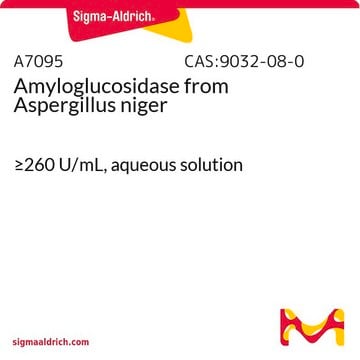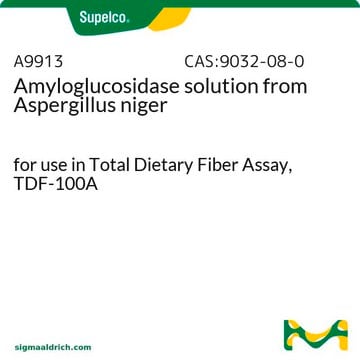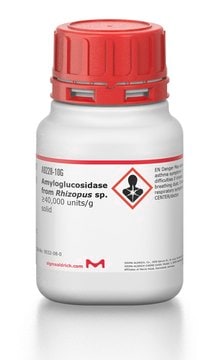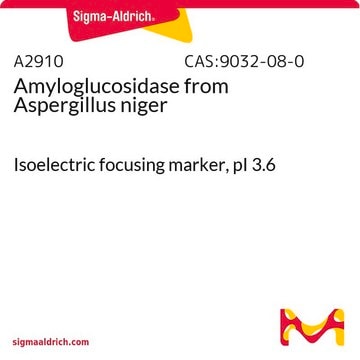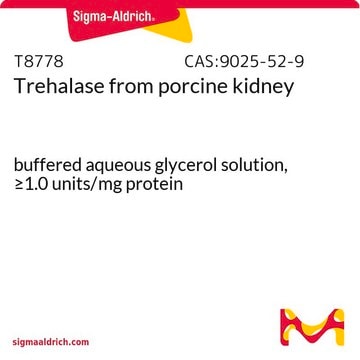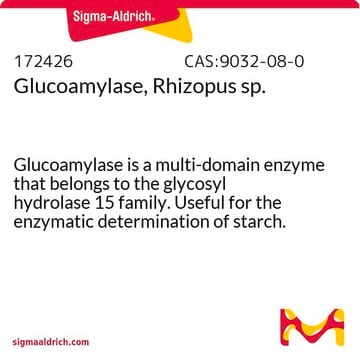This product is filled by density, with a target fill volume of 0.5 ml for the 25mg and 2.0 ml for the 100mg package sizes.
A1602
Aminoglucosidasa from Aspergillus niger
ammonium sulfate suspension, ≥40 units/mg protein
Sinónimos:
1,4-α-D-Glucano glucohidrolasa, Exo-1,4-α-glucosidasa, Glucoamilasa
Seleccione un Tamaño
123,00 €
Seleccione un Tamaño
About This Item
123,00 €
Productos recomendados
Formulario
ammonium sulfate suspension
Nivel de calidad
actividad específica
≥40 units/mg protein
Condiciones de envío
wet ice
temp. de almacenamiento
2-8°C
¿Está buscando productos similares? Visita Guía de comparación de productos
Descripción general
Aplicación
Acciones bioquímicas o fisiológicas
Definición de unidad
Forma física
Otras notas
Código de clase de almacenamiento
12 - Non Combustible Liquids
Clase de riesgo para el agua (WGK)
WGK 2
Punto de inflamabilidad (°F)
Not applicable
Punto de inflamabilidad (°C)
Not applicable
Equipo de protección personal
Eyeshields, Gloves, multi-purpose combination respirator cartridge (US)
Listados normativos
Los listados normativos se proporcionan para los productos químicos principalmente. Para los productos no químicos sólo se puede proporcionar información limitada. Si no hay ninguna entrada, significa que ninguno de los componentes está en la lista. Es obligación del usuario garantizar el uso seguro y legal del producto.
EU REACH Annex XVII (Restriction List)
Elija entre una de las versiones más recientes:
Certificados de análisis (COA)
¿No ve la versión correcta?
Si necesita una versión concreta, puede buscar un certificado específico por el número de lote.
¿Ya tiene este producto?
Encuentre la documentación para los productos que ha comprado recientemente en la Biblioteca de documentos.
Los clientes también vieron
Artículos
Instructions for working with enzymes supplied as ammonium sulfate suspensions
Protocolos
This procedure may be used for the determination of Amyloglucosidase activity using starch as the substrate.
-
What volume of ammonium sulfate is the 25mg suspended in?
1 respuesta-
¿Le ha resultado útil?
-
-
How can a 1mg/mL solution of amyloglucosidase A1602 be prepared in acetate buffer?
1 respuesta-
The product A1602 is in an ammonium sulfate solution. Here's how you can work with this product:
- If the ammonium sulfate might interfere with the reaction(s):
1. Remove the enzyme from the refrigerator, ensuring that the ammonium sulfate suspensions are not frozen.
2. Gently invert the vial or bottle to produce a milky suspension. Avoid using harsh treatments like vortexing or sonicating, as they may denature some of the enzyme.
3. Use a pipette and sterile wide-bore pipette tip to remove a portion of the suspension.
4. Transfer the portion to a clean microcentrifuge or centrifuge tube.
5. Pellet the enzyme by centrifuging at approximately 10,000 – 15,000 x g for 10 minutes, if possible, using a refrigerated microcentrifuge set to a temperature between 2 °C and 8 °C.
6. Carefully remove as much clear supernatant as possible, retaining it; it is not necessary to remove absolutely all of the ammonium sulfate solution.
7. Dissolve the pellet by adding an appropriate amount of reaction buffer.
8. Assay the supernatant and the solution from the pellet for protein content and/or enzyme activity.- If the ammonium sulfate will not interfere with the reaction(s), follow the same steps as above.
It's important to note that for an ammonium sulfate suspension, most of the enzyme will be in solid form, and only negligible amounts of enzyme will likely be in the ammonium sulfate solution.
Alternatively, there are several Amyloglucosidase enzymes available in solid form (e.g., Product A7420 and A9228) that can be suspended in a solvent of your choice.
¿Le ha resultado útil?
-
Filtros activos
Nuestro equipo de científicos tiene experiencia en todas las áreas de investigación: Ciencias de la vida, Ciencia de los materiales, Síntesis química, Cromatografía, Analítica y muchas otras.
Póngase en contacto con el Servicio técnico